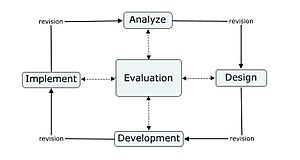Etapes de conception
Cet article est une ébauche à compléter. Une ébauche est une entrée ayant un contenu (très) maigre et qui a donc besoin d'un auteur.
Modèle:Redirect Modèle:More footnotes
The ADDIE model is a framework that lists generic process that instructional designers and training developers use. [1]It represents a guideline for building effective training and performance support tools in five phases.
- Analysis
- Design
- Development
- Implementation
- Evaluation
It is an Instructional Systems Design (ISD) model. Most current ISD models are variations of the ADDIE process.[2] other models include the Dick & Carey and Kemp ISD models. Rapid prototyping is a commonly accepted improvement to this model. This is the idea of reviewing continual or formative feedback while creating instructional materials. This model strives to save time and money by catching problems while they are still easy to fix.
Instructional theories also play an important role in the design of instructional materials. Theories such as behaviorism, constructivism, social learning, and cognitivism help shape and define the outcome of instructional materials.
History
Florida State University initially developed the ADDIE model to explain, “...the processes involved in the formulation of an instructional systems development (ISD) program for military interservice training that will adequately train individuals to do a particular job and which can also be applied to any interservice curriculum development activity.”[3] The model originally contained several steps under its five original phases (analyze, design, develop, implement, and evaluate).[3] The idea was to complete each phase before moving to the next. Over the years, practitioners revised the steps, and eventually the model became more dynamic and interactive than the original hierarchical version. By the mid-1980s, the version familiar today appeared.
Phases of ADDIE
Analysis phase
The analysis phase clarifies the instructional problems and objectives, and identifies the learning environment and learner's existing knowledge and skills. Questions the analysis phase addresses include:
- Who are the learners and what are their characteristics?
- What is the desired new behavior?
- What types of learning constraints exist?
- What are the delivery options?
- What are the pedagogical considerations?
- What adult learning theory considerations apply?
- What is the timeline for project completion?
Design phase
The design phase deals with learning objectives, assessment instruments, exercises, content, subject matter analysis, lesson planning, and media selection. The design phase should be systematic and specific. Systematic means a logical, orderly method of identifying, developing and evaluating a set of planned strategies targeted for attaining the project's goals. Specific means each element of the instructional design plan must be executed with attention to details.
In the design phase, developers:
- Document the instructional, visual, and technical design strategy
- Apply instructional strategies according to intended behavioral outcomes by domain (cognitive, affective, and psychomotor)
- Design the user interface and user experience
- Create a prototype
- Apply visual design (graphic design)
Development phase
In the development phase, instructional designers and developers create and assemble content assets blueprinted in the design phase. In this phase, the designers create storyboards and graphics. If e-learning is involved, programmers develop or integrate technologies. Testers debug materials and procedures. The project is reviewed and revised according to feedback.
Implementation phase
The implementation phase develops procedures for training facilitators and learners. Training facilitators cover the course curriculum, learning outcomes, method of delivery, and testing procedures. Preparation for learners includes training them on new tools (software or hardware) and student registration. Implementation includes evaluation of the design.
This is also the phase where the project manager ensures that books, hands-on equipment, tools, CD-ROMs, and software are in place, and that the learning application or website functions.
Evaluation phase
The evaluation phase consists of two parts: formative and summative. Formative evaluation is present in each stage of the ADDIE process.
See also
References
Modèle:Reflist Modèle:Refbegin
- Modèle:Cite journal Amended version available at the author's web site at Indiana University (Bloomington).
- Modèle:Cite web
- ↑ Morrison, Gary R. Designing Effective Instruction, 6th Edition. John Wiley & Sons, 2010.
- ↑ Piskurich, G.M. (2006). Rapid Instructional Design: Learning ID fast and right.
- ↑ 3,0 et 3,1 Branson, R. K., Rayner, G. T., Cox, J. L., Furman, J. P., King, F. J., Hannum, W. H. (1975). Interservice procedures for instructional systems development. (5 vols.) (TRADOC Pam 350-30 NAVEDTRA 106A). Ft. Monroe, VA: U.S. Army Training and Doctrine Command, August 1975. (NTIS No. ADA 019 486 through ADA 019 490).
